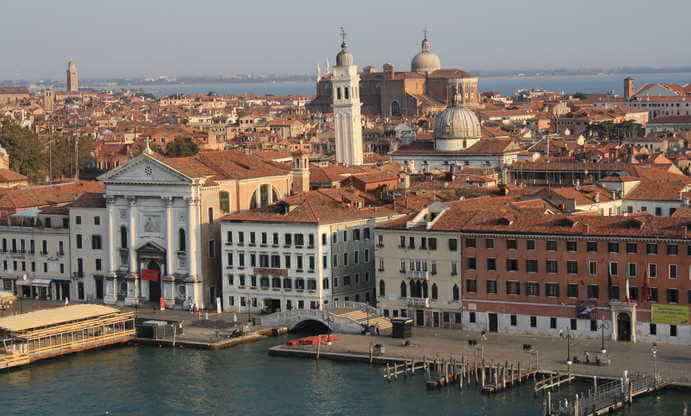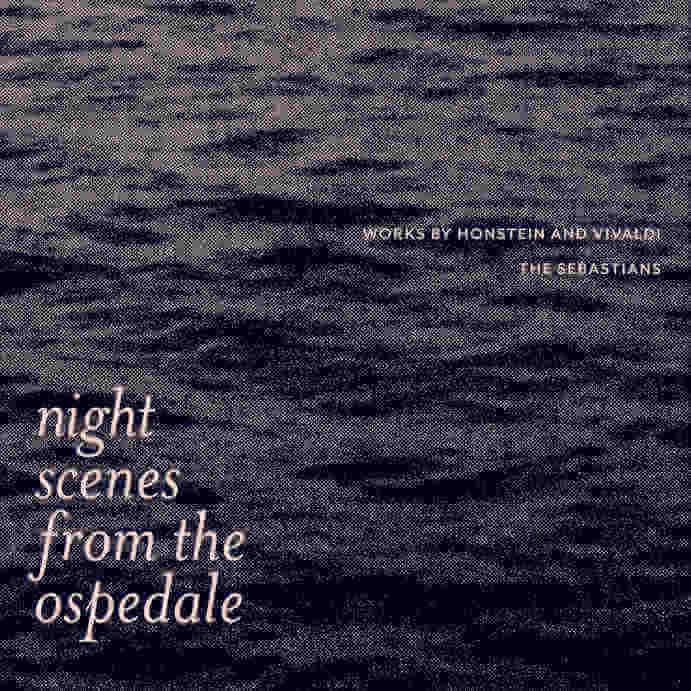What distinguishes good from outstanding in a performing artist? It seems that the best performers have control over a widely-varied palette of expressive tools from which to draw– tone colors, vibrato, articulation, rubato, dynamics and so forth, but what happens when some of these tools are stripped away in the name of historical performance practice? In their debut album, Night Scenes from the Ospedale (Soundspells Productions), the members of early-music ensemble The Sebastians achieve beautifully-nuanced playing and thoughtful expressivity within the realm of baroque performance.
The album features the juxtaposition of four Vivaldi concerti from L’estro Armonico with a set of newly-commissioned “night interludes” by composer Robert Honstein. Vivaldi is perhaps most recognized for his work at the Ospedale della Pietà, one of four Venetian institutions for orphaned, illegitimate, and poor children. The Pietà specialized in the musical training of young girls, and Vivaldi’s tenure as master of violin, and later, master of concerts lasted from 1703-1740. L’estro Armonico (1711) is a set of 12 concerti for one, two, and four solo violins and has been cited as one of the most important works of the first half of the 18th-century.
Contrastingly, Robert Honstein’s Night Scenes from the Ospedale imagines the sonic landscape of the Pietà in the evening following the buzz of daily rehearsals and concerts. Honstein is a Boston-area composer, co-founder of the Sleeping Giant composer collective, and co-director of Fast Forward Austin music festival. Night Scenes creates a stark contrast to the lively Vivaldi concerti and introduces a foreign realm of timbres to the instrumentation of a baroque ensemble.

Ospedale della Pieta
The album begins with Night Scene #1. Titled “Barcarolle,” a song traditionally sung by Venetian gondoliers, this interlude features the atmospheric and ambient sounds of an old building at night creaking in the wind. A lone cello emerges followed by pitch bending in the strings and harpsichord. Coherent bits of melody begin to form as part of an additive texture before a surprising B-major cadence.
The album promptly segues into Vivaldi’s Concerto in A minor, RV 522. Featuring violin solists Daniel S. Lee and Katie Hyun, the first movement of this concerto showcases the pristine articulation, impeccable intonation, flawless technique, and well-executed dynamic contrasts of this balanced ensemble. The second movement demonstrates Lee and Hyun’s range of expressivity sans vibrato, and they both succeed in creating stunning tension and release of the melodic line. Particularly impressive in this movement is the ability of the string players to match the rate of decay present in the harpsichord, thus highlighting The Sebastians’ extreme attention to detail. The sprightly third movement displays crisp articulation and solid ensemble interplay between the two solo lines.
Following the Concerto in A minor, RV 522 is Night Scene #2 (Lamento). This interlude explores timbral differences between bowed and plucked strings. Honstein enhances this relationship with pitch bending, drones, and creaking sounds. The ensuing Concerto in G major, RV 310 is extraordinarily vivacious-sounding in comparison. Violin soloist Beth Wenstrom delivers an engaging performance with beautiful yet subtle nuance and pacing to her phrases.
Night Scene #3 (Notturno) opens with sounds of the wind, creaking floor boards, and knocking before introducing the harpsichord and a distant, barely-audible song. This is the first interlude to prominently feature the harpsichord, and Honstein’s writing paints the scene of a lone keyboardist practicing late at night who periodically pauses to listen to the building before responding to its chorus of sounds.
The Sebastians
The Concerto in B minor, RV 580 boasts a larger roster of soloists including previously-featured violinists Lee, Hyun, and Wenstrom, violinist Nicholas DiEugenio, and cellist Ezra Selter. The five soloists become another terraced level of chamber music unto themselves, yet each individual voice still maintains its slightly distinct color. Ghosts of motivic fragments from the last movement of this concerto continue over into Night Scene #4 (Bisbigli). Named after the Italian word for “whispers,” this interlude pits bursts of Vivaldian rhythmic activity in the high strings against long sustained tones in the low strings and fragments of a harpsichord improvisation.
The final Vivaldi work on the album, Concerto in D major, RV 539, features the same instrumentation as the preceding concerto yet contains more extensive solo lines for the cello, which Ezra Selter navigates with technical finesse. The closing selection is Night Scene #5 (Prima l’alba) in which Honstein employs a chorale-like texture with sustained harmonies in the strings. It is the most consonant-sounding of the interludes and suggests a scene right before dawn.
Within the context of this album, Honstein’s Night Scenes serve well as sonic breaks between the oft-homogenous texture of Vivaldi, but there is a question of longevity that begs to be answered–the work fulfills the purpose of the commission and completes the aesthetic of the album, but is it sustainable? Is there hope for subsequent performances as a standalone work? Must this work always be paired with Vivaldi? Regardless, The Sebastians and Robert Honstein have created a technical and timbral tour-de-force which delves into issues of temporality by placing the listener in a specific point and location in time.

